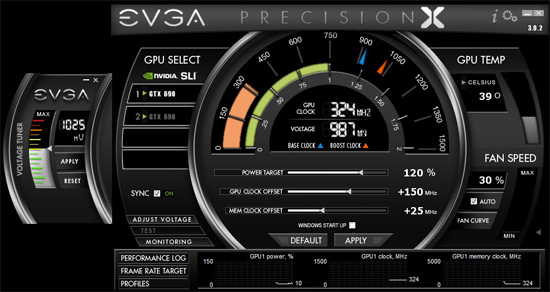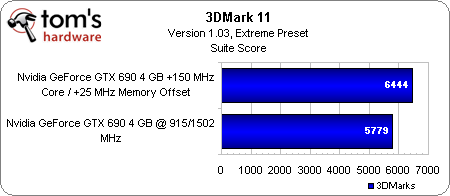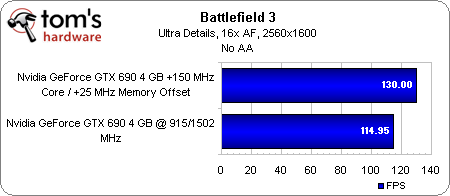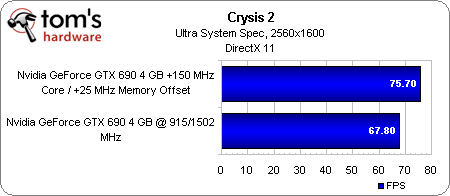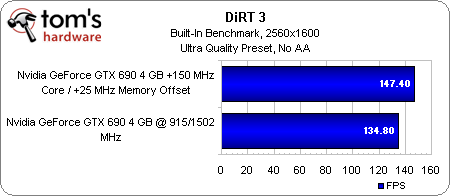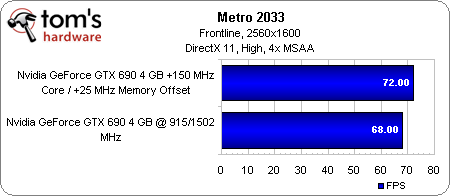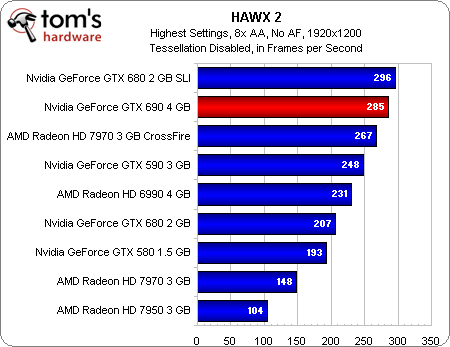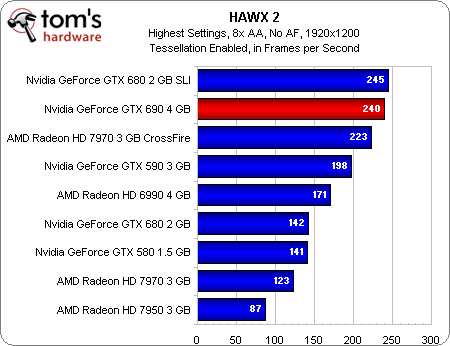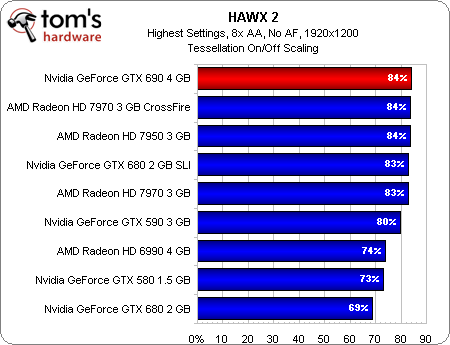GeForce GTX 690 Review: Testing Nvidia's Sexiest Graphics Card
We already know that Nvidia's GeForce GTX 690 sports two GK104s and is priced at $1000. But hardware like this is fun to read about. Oh, you actually want to buy one? Expect performance just shy of two GTX 680s in SLI, and good luck tracking one down!
Overclocking And Tessellation Performance
Overclocking GeForce GTX 690
Beyond simply building a more capable cooler, Nvidia claims that hand-picking low-leakage GK104 GPUs helps minimize the GeForce GTX 690’s thermal output. As a result, the card slides in under a 300 W TDP. But company representatives say there is plenty of headroom left in the card for clock rates beyond the stock 915 MHz base and 1019 MHz typical GPU Boost frequency.
Using EVGA’s excellent Precision X tool, we managed to push a 150 MHz core and 25 MHz memory offset using a 20%-higher power target. Stability was marginal at those settings, though, so we nudged the voltage up from its .988 V default up to 1.025 V, which kept the card from crashing.
The resulting gains aren’t bad, ranging from a 13%+ speed-up in Battlefield 3 to a 5%+ boost in Metro 2033 at 2560x1600.
Tessellation
You can call it tradition by this point. Our examination of tessellation scaling is intended to quantify claims that both Nvidia and AMD make regarding continually-improving implementations of geometry processing. We like to use real-world metrics where possible, and HAWX 2 gives us an easy on/off toggle for applying additional vertices.
The only real take-away here is that a GeForce GTX 690 does as well as two GeForce GTX 680s in SLI, which improve on what a single GeForce GTX 680 achieves on its own. We’re not sure why the 680 bleeds off so much of its performance when you turn tessellation on, but there’s clearly a bottleneck hammering the frame rate harder than geometry.
Get Tom's Hardware's best news and in-depth reviews, straight to your inbox.
Current page: Overclocking And Tessellation Performance
Prev Page GeForce GTX 690 4 GB: Hands-Off The Magnesium, Pal! Next Page PCI Express 3.0 And What Of GK110?-
robwright I wonder, given the price of the 690, just how limited the quanitities will be. Which brings up another question, one that Nvidia (and AMD as well) would probably be reluctant to answer: are they making and shipping fewer of the top-shelf Halo cards today than they did 5 or six years ago?Reply -
rebel1280 ....... Lamborghini’s Reventón ...... +infinity for mentioning that work of art T_T didn't even read the article until after I got my fix for the Lamborghini’s Reventón on the net haha. That car may be the only proof left to us of the old gods, in particular Mercury (god of transport) lolReply -
lahawzel 680s are already nearly nonexistent, so I expect these 690s to be just as mythical and hard-to-find as the Radeon 6990.Reply -
phamhlam LaHawzel680s are already nearly nonexistent, so I expect these 690s to be just as mythical and hard-to-find as the Radeon 6990.Reply
6990 aren't that hard to find. Back in January before the 7000 series came out, you could easily pick one or two up. I am pretty sure in 6 month, the 690 will be easy to grab. -
frombehind I wonder if someone will come out with a version that has a stock water-cooler built in? Then it really would the card to get ^^Reply
